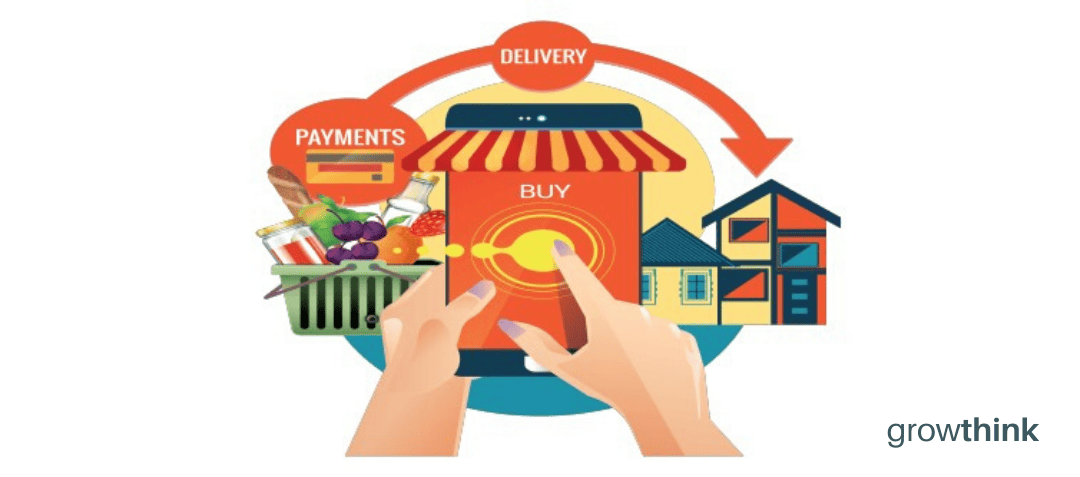On This Page:
- How to Start an Ecommerce Business
- How Big is the Ecommerce Industry?
- What are the Key Segments of the Ecommerce Industry?
- What are the Key Trends in the Ecommerce Industry?
- What External Factors Affect the Ecommerce Industry?
- Who are the Key Competitors in the Ecommerce Market?
- What are the Key Customer Segments in the Ecommerce Market?
- What are the Typical Startup Costs for a New Ecommerce Business?
- What are the Keys to Launching a New Ecommerce Business?
- How to Start an Ecommerce Business FAQs
- Additional Resources
Ecommerce is defined as buying and selling items online. If you want to sell something anywhere on the web where there are groups of people looking to buy whatever product you’re offering then an e-commerce business may be for you. E-commerce entrepreneurs can build a successful business by following and utilizing the tips and insights into the ecommerce industry below.
Importantly, a critical step in starting an ecommerce business is to complete your business plan. To help you out, you should download Growthink’s Ultimate Ecommerce Business Plan Template here.
How to Start an Ecommerce Business
-
Conduct Market Research and Pick Your Niche
The very first step in starting an ecommerce business is to identify a profitable niche. This means doing some research to figure out what products or services people are searching for and willing to pay for online.
It’s important to choose a niche that you have some knowledge about and are interested in, as this will make it easier to create valuable content and build your site.
-
Create an Ecommerce Business Plan
The most important step in starting any business is creating a solid business plan. This document will be your roadmap to success, so it’s important to take the time to get it right. Your business plan should include information about your business goals, target customers, product or service offerings, marketing strategy, financial forecasts, and the amount of start-up capital necessary to execute your ecommerce business plan.
To enhance your planning process, incorporating insights from a sample ecommerce business plan can be beneficial. This can provide you with a clearer perspective on industry standards and effective strategies, helping to solidify your own business approach.
-
Select an Ecommerce Platform
Selecting the right e-commerce platform is essential to success in an ecommerce business. For this step, it’s important that you select a system that will meet your needs for years into the future. You should also take care to select a platform that is search engine friendly, as this will be critical to driving traffic to your site.
-
Secure Your Domain Name and Hosting
In order to have a professional ecommerce site, you’ll need to secure a domain name and hosting. The domain name is your website’s address on the internet while hosting provides the space for your website files to be stored on the internet. You can find hosting services that are search engine friendly, offer e-commerce integration, and provide advanced security options. Ensure that you also select a reputable host with helpful customer service.
-
Design Your Online Store
The design of your online store is extremely important, as it will be the first impression that potential customers have of your business. It’s important to select a theme and layout that is professional and easy to navigate. You’ll also want to make sure that your online store is responsive so that it looks great on all types of devices.
-
Set Up Your Payment Processing
In order to receive payments from customers, you’ll need to set up a payment processing system. There are a number of different payment processing systems available, so it’s important to select one that meets your needs and is compatible with your e-commerce platform.
-
Develop a Marketing Strategy
A successful ecommerce business requires a comprehensive marketing strategy. This strategy should include a mix of online and offline marketing tactics, such as search engine optimization, social media marketing, email marketing, and print advertising.
-
Launch Your Ecommerce Store and Promote It
Once your online store is ready to launch, it’s important to promote it extensively. You can do this by creating a website launch plan that includes a mix of online and offline marketing tactics. You should also consider using paid advertising to help jumpstart your sales.
Finish Your Business Plan Today!
If you’d like to quickly and easily complete your business plan, download Growthink’s Ultimate Ecommerce Business Plan Template and complete your plan and financial model in hours.
How Big is the Ecommerce Industry?
The global e-commerce industry is worth an estimated $4.28 trillion and is expected to grow to $5.4 trillion in the next couple of years. This makes it one of the fastest-growing industries in the world.
What are the Key Segments of the Ecommerce Industry?
The global e-commerce industry can be broken down into three key segments:
- Business-to-Business (B2B) – This segment refers to transactions between businesses, such as companies that sell products to retailers.
- Business-to-Consumer (B2C) – This segment refers to transactions between businesses and consumers, such as a retailer that sells ecommerce products to the public.
- Consumer-to-Consumer (C2C) – This segment refers to transactions between individuals, such as an individual that sells used clothing to another individual.
What are the Key Trends in the Ecommerce Industry?
The key trends in the e-commerce industry include increasing mobile traffic, increasing use of social media for marketing, and increased security concerns.
What External Factors Affect the Ecommerce Industry?
Ecommerce businesses need to identify external factors that affect the e-commerce industry in order for business owners to make decisions that will help their ecommerce stores thrive. The external factors that affect the e-commerce industry include:
Economic Conditions - The state of the economy has a major impact on consumer spending, which affects ecommerce businesses.
Political Conditions – Political instability can lead to bans on e-commerce activities, as well as changes in tax laws that can affect ecommerce businesses.
Technology Changes – Rapid changes in technology can have a major impact on the e-commerce industry, both positively and negatively. For example, social media platforms have created a new type of marketing that relies on the use of social networks to increase brand name awareness and sales. On the other hand, technical issues can affect website performance and prevent users from accessing websites.
Environmental Conditions – Natural disasters, such as hurricanes and earthquakes, can damage infrastructure and disrupt business operations including shipping costs and timelines.
Who are the Key Competitors in the Ecommerce Market?
The key competitors in the e-commerce market include online merchants (such as Amazon, eBay, and other product-based online retailers) and brick-and-mortar businesses (such as retail stores).
What are the Key Customer Segments in the Ecommerce Market?
Large and small business owners should be aware of the different customer segments in the e-commerce target market. The five key customer segments include:
- Premium – These customers expect the best things in life and are willing to pay a premium for them. They typically shop online via brand websites and high-end retailers and spend an average of $1,500 per month on goods and services.
- Mass Affluents – These customers are fiscally conservative and money-conscious, but still find ways to spend generously on luxuries. They typically shop online via department stores and other retailers and spend an average of $500 per month on consumer goods and services.
- Bargain Hunters – These customers like a good deal and love a sale. They typically shop online via discount retailers and spend an average of $200 per month on consumer goods and services.
- Specialists – These customers have a passion for something, such as art or technology, and love to talk about it with others. They typically shop online via specialty retailers and spend an average of $300 per month on goods and services.
- Window Shoppers – These customers are just looking. They typically shop online via general retailers and spend an average of $150 per month on goods and services.
What are the Typical Startup Costs for a New Ecommerce Business?
The typical startup costs for a new online business can range from $5,000 to $50,000. The amount of money you’ll need to start an ecommerce business depends on the type of business you want to create, the physical products you plan to sell, and the technology you’ll need to get started.
The key business costs to launching an online business include:
- Product Inventory – The cost of acquiring and stocking the inventory necessary to run your business.
- Website Development – The cost of designing, building, and maintaining a website.
- Domain Name and Hosting – The cost of registering a domain name and hosting your website.
- Marketing and Online Advertising – The cost of marketing your online business to your target audience and encouraging repeat customers.
- Shipping and Handling – The cost of shipping and handling products to customers.
- Customer Service – The cost of providing support to customers.
What are the Keys to Launching a New Ecommerce Business?
The keys to launching a profitable online store include:
- Understanding the Ecommerce Landscape – Knowing who the key competitors are and understanding the customer segments in the e-commerce market is essential for success.
- Developing a Strong Ecommerce Business Plan – Having a detailed e-commerce business plan will help you map out your goals and objectives, as well as track your progress along the way.
- Choosing the Right Ecommerce Platform – Selecting the right ecommerce platform is critical for launching a business online. There are a number of different platforms to choose from, so do your research to find the one that best suits your needs.
- Creating Engaging and Useful Content – Producing engaging and useful content is essential for attracting and retaining customers. This content can take many different forms, such as blog posts, product descriptions, or how-to guides linked from each of the product pages.
- Building an Email List – Building an email list is a key component of any successful online business. This list can be used to promote new products, announce sales and discounts, and more.
- Offering Ancillary Products and Services – Offering ancillary products and services allows you to expand your customer base, increase overall sales, and gain more exposure for your business.
- Maintaining Your Online Presence – Maintaining your online presence is critical for success. This includes monitoring customer reviews on third-party websites, responding to questions and comments on social media, and more.
- Researching the Competition – Understanding your competitors is critical for success. You can use SWOT analysis to learn about your competition’s products and services, marketing strategies, website design, and more.
- Learning from Other Ecommerce Business Owners – Learning from other e-commerce business owners is an effective way to gain useful insights on what works and what doesn’t.
- Understanding the Legal Implications – It’s important to understand all of the legal implications involved with running an e-commerce business. Failure to comply with federal, state, or local laws can lead to fines or other penalties.
- Paying Taxes on Your Business Income – You’ll need to pay taxes on the income generated by your ecommerce business. This includes federal, state, and local income taxes, as well as self-employment taxes.
Launching a successful ecommerce business takes time, effort, and planning. But with the right tools and knowledge, it can be done. By following the tips above, you’ll be on your way to starting a thriving ecommerce business.
How to Finish Your Ecommerce Business Plan in 1 Day!
Don’t you wish there was a faster, easier way to finish your ecommerce business plan?
With Growthink’s Ultimate Ecommerce Business Plan Template you can finish your plan in just 8 hours or less!
Click here to finish your ecommerce business plan today.
How to Start an Ecommerce Business FAQs
What are the pros and cons of starting an ecommerce store?
Starting your own ecommerce business has pros and cons just like any other business. The main pro is that you can reach a larger target audience than if you were selling through a brick-and-mortar business. You also have the potential to make more money since there are no physical boundaries on what you can sell.
The main con is that it can be more difficult to get your business off the ground since you need to have a strong online presence. You also need to be comfortable with managing and running a website.
What are the initial steps I need to take to start an ecommerce business?
The first step is to come up with a business idea. This can be anything from selling your own products to providing a service to others. Once you have a business idea, you need to do some research and create a business plan. The business plan should include details about your product and service, target audience, location, and competition.
Once the research is done and the business plan has been created you need to come up with a business name and register it with your local government. Once that's all taken care of you can start working on building an e-commerce website. It does not have to be an extremely complicated site; in fact, most new ecommerce businesses rely on simple and user-friendly websites with good product descriptions and quality photographs.
It is also a good idea to join associations like the Better Business Bureau (BBB) and the Electronic Commerce Association (ECA).
What are some of the biggest challenges I will face when starting an ecommerce company?
The biggest challenges you will face are marketing and logistics. You need to find a way to let potential customers know that your business exists, and then figure out how to get the products to them. This can be done through online marketing techniques like search engine optimization (SEO), pay-per-click advertising (PPC), social media marketing, and email marketing. You will also need to find a good freight forwarder to help with shipping the products.
What are some of the most common mistakes people make when starting an ecommerce business?
The most common mistakes people make are not doing their research, not having an ecommerce business plan, and not spending enough money on marketing.
Others may include not setting up their website correctly, not having a clear return policy, and not choosing the right payment processing system.
How can I make sure my ecommerce business is successful?
There are a few things you can do to make sure your ecommerce business is successful. First, make sure you provide what your customers are looking for. It is very important that you know your target market and what they want before you create the website. Next, make sure your online marketing efforts are consistent and ongoing. Finally, make sure to track data about everything related to the online store (visitors, sales) so that you can adjust your business as it grows.
Where Can I Download a Ecommerce Business Plan PDF?
You can download our ecommerce business plan PDF template here. This is a business plan template you can use in PDF format.


 Business Plan Template & Guide For Small Businesses
Business Plan Template & Guide For Small Businesses How To Write A Great Business Plan
How To Write A Great Business Plan 100 Business Plan Examples To Use To Create Your Plan
100 Business Plan Examples To Use To Create Your Plan